Chile, stretching over 4,300 kilometers along the western edge of South America, is a world-renowned winemaking country that marries rich historical practices with unique geographic elements to produce wines of exceptional character.
The country’s vast latitudinal range endows it with a variety of climates and terroirs, which when coupled with innovative winemaking techniques, result in a diverse spectrum of wine styles. Chilean wine regions boast a wine for every palate, from the robust reds of the Maipo Valley to the crisp whites of the Casablanca Valley.

Each valley offers a distinct wine-tasting experience, deeply influenced by the natural juxtaposition of the Andes mountains and the cool currents of the Pacific Ocean. The Aconcagua, Colchagua, and Cachapoal Valleys are just a few areas where the interplay of climate and terroir come to life. Beyond their natural beauty, these regions are home to top vineyards and wineries that are part of Chile’s burgeoning wine industry, offering a rich exploration for the curious wine lover.
Key Takeaways
- Chile’s diverse climates and terrains produce a wide array of wine styles.
- Innovative winemaking and a rich history contribute to Chile’s wine excellence.
- The country’s major wine valleys offer unique tasting experiences for all enthusiasts.
History of Chilean Wine
Chile’s wine history is deeply rooted in a blend of tradition and innovation, starting with the Spanish conquest and leading to the modern era of winemaking that has placed Chilean wines on the global stage.
Spanish Influence
The Spanish Conquistadores introduced viticulture to Chile in the 16th century. You might find it fascinating that the first vines were likely planted by priests needing wine for the Catholic Eucharist. Over time, a grape known locally as Pais became the most widely planted varietal. This period established the foundation of Chile’s winemaking, as vineyards began to flourish primarily in the Central Valley region.
Bordeaux Varietals Introduction
By the mid-19th century, a significant transformation occurred. Wealthy Chileans who had traveled to France brought back noble Bordeaux grape varieties, including Cabernet Sauvignon, Merlot, and Carménère. The latter, forgotten for years, was discovered among the Merlot vines, where it had been mistaken for Merlot itself. It’s now regarded as Chile’s signature grape, symbolizing the successful integration of Bordeaux varietals into the diverse Chilean terroir.
Modern Era of Winemaking
In the late 20th and early 21st centuries, Chilean wine underwent a renaissance. Winemakers began investing in modern techniques, focusing on quality and innovation. This new phase catapulted Chilean wines onto the world stage. High-quality winemaking regions, such as the Maipo Valley near Santiago, are now celebrated for their premium wines, especially robust reds that reflect both the history and the potential of Chilean winemaking.
Geographic Influence on Viticulture
The landscape of Chile offers unique conditions for winegrowing, primarily shaped by the Andes Mountains, the cooling effects of the Pacific Ocean, and the diverse Central Valley.
Role of the Andes Mountains
The Andes Mountains are not just a majestic backdrop for Chile’s vineyards; they’re a pivotal part of the viticulture here. The high altitude and the slopes provide a range of microclimates, which result in the opportunity to grow a variety of grapes. The mountainous terrain means you’ll find vineyards at elevations up to 2,200 meters, leading to significant diurnal temperature variation that helps grapes to develop a balance between sugar and acidity, crucial for crafting fine wines.
Influence of the Pacific Ocean
A moderate cool climate for winegrowing is bestowed upon certain Chilean regions thanks to the Pacific Ocean. Its cold Humboldt Current brings cooling breezes and morning fog to coastal areas, reducing temperatures.
This moderating effect allows for a longer ripening period, which is essential for developing complex flavors and aromas in grapes. For varieties like Pinot Noir and Chardonnay, this influence is particularly beneficial, allowing them to thrive in Chile’s coastal zones.
Central Valley and its Subregions
Chile’s Central Valley is the heartland of the country’s wine production. It’s a vast area, with a diverse range of topography and microclimates influenced by both the Andes and the ocean. The valley is composed of several renowned subregions, each with its own distinct character.
For instance, the Maipo Valley, known for its premium Cabernet Sauvignon, enjoys a warm climate tempered by altitude and the river breezes, while the cooler Casablanca Valley is famous for its Sauvignon Blanc and Pinot Noir, benefiting from oceanic influences.
Major Wine Regions of Chile

As you explore Chile’s wine regions, it’s like embarking on a journey through a variety of climates and soils, each imparting unique qualities to their wines. Here are some key regions worth your attention:
- Maipo Valley: Nestled near Santiago, the capital, this is the oldest and most celebrated region, known mainly for its robust Cabernet Sauvignon wines. The valley has sub-regions like Alto Maipo, which is lauded for high-quality production due to its elevation.
- Aconcagua Valley: This region, particularly the sub-region Aconcagua Costa, is recognized for its fine Syrah and Cabernet. The coastal influence here moderates the temperature, ideal for such varietals.
- Casablanca Valley: With its cooler climate, due to coastal breezes from the Pacific, this region is a haven for Chardonnay and Sauvignon Blanc, offering a crisper, more mineral-driven flavor profile.
- Colchagua Valley: Here, you’ll find some of Chile’s most prestigious red wines, including exemplary Carmenere, a grape that has become a symbol of Chile’s wine identity.
- Cachapoal Valley and Maule Valley: Both are integral parts of the Central Valley and are known for their diverse production, with Maule producing bulk and premium wines and Cachapoal noted for fine reds.
- San Antonio and Leyda Valleys: These coastal zones are gaining fame for their cool-climate varieties, including Sauvignon Blanc and Pinot Noir.
- Elqui and Limarí Valleys: Located further north, these valleys are experimenting with Syrah and Chardonnay, benefiting from the clear, high-altitude light and diurnal temperature shifts.
- Bío-Bío and Itata Valleys: Move south to find these emerging areas where traditional methods meet innovative approaches, giving life to old-vine País and Moscatel.
Each Chilean wine region offers a unique vignette into South America’s winemaking prowess, making Chile a fascinating destination for oenophiles. Enjoy discovering the varied landscapes and the exceptional wines they produce.
Maipo Valley

When exploring Chile’s wine regions, your journey isn’t complete without a visit to the Maipo Valley. Located just south of Santiago, you’ll find this valley an accessible and renowned destination for wine aficionados like yourself. It’s known for its premium Cabernet Sauvignon, a variety you might find robust and flavorful.
The Maipo Valley encompasses three areas, each with its unique characteristics:
- Alto Maipo: Closer to the Andes, it’s the source of some of the most prestigious wines, marked by their strong mineral notes due to the alluvial origin of the soils.
- Central Maipo: The heart of the valley, where you’ll taste wines with a balance between fruit and oak.
- Maipo Bajo: Closer to the coast, known for producing softer and fruitier wines.
The climate in Maipo Valley is Mediterranean, conducive to viticulture, with warm, dry summers and cool, wet winters. This climate ensures that the grapes are ripe and full of flavor. Discover the valley’s wines and understand why they are often celebrated for their quality and complexity.
For more specifics on the intricacies of Maipo Valley wines, the Vivino guide to the Maipo Valley would be a handy resource. If you’re planning a visit, consider the expert-guided tours and personal itineraries suggested on Winerist, or delve into a list of the top wineries to visit in 2023 curated by Winetourism.com.
Remember, whether you’re sipping a glass at a vineyard or selecting a bottle to enjoy at home, the wines from Maipo Valley are not just drinks, but a reflection of Chile’s rich winemaking heritage.
Aconcagua Valley
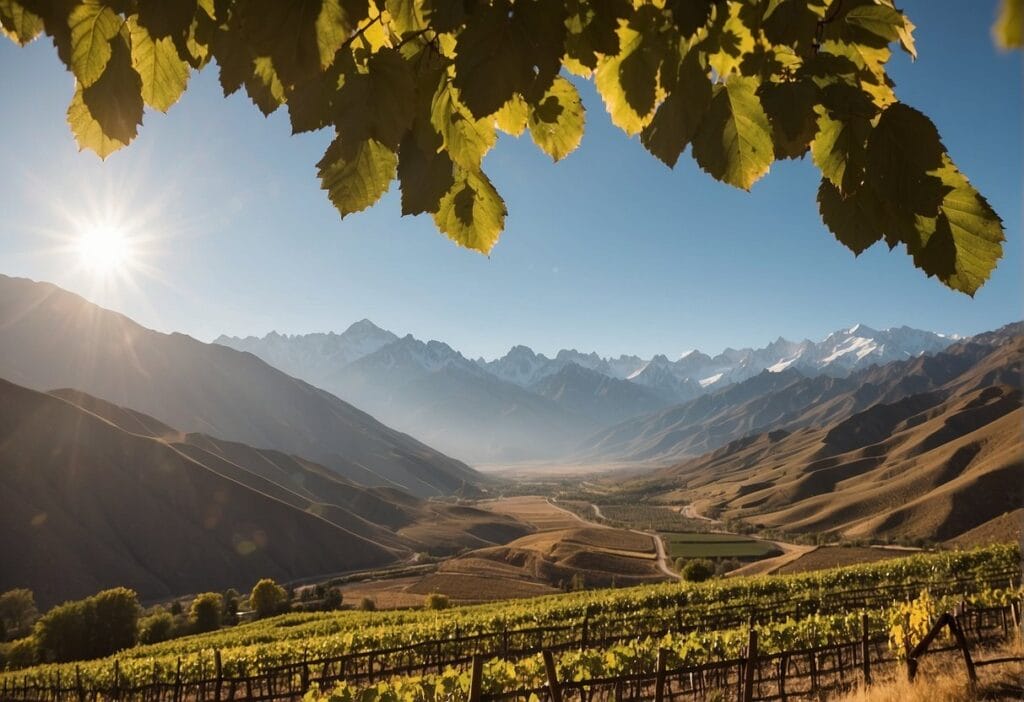
Located just 65 km north of Santiago, the Aconcagua Valley is a dynamic wine-producing region you’ll find in eastern Valparaíso. The valley is renowned for its Denomination of Origin (DO) status, which signifies its legally protected geographical indication.
The climate here is predominantly hot and dry, making it an ideal spot for cultivating robust red wines. Cabernet Sauvignon, Syrah, and Merlot are some of the standout varieties that have elevated Aconcagua’s reputation. Initially thought to be unsuitable for wine production, the valley has defied expectations with its high-quality wines.
When you explore Aconcagua, you’re also exploring a part of Chile’s wine history. Vineyards stretch from close to the Pacific Ocean, over a distance of approximately 100km, offering a scenic vista. The region derives its name from the highest peak in the Americas, Mount Aconcagua, and from the river that ribbons through it, the Aconcagua River.
Key Grape Varieties:
- Cabernet Sauvignon
- Syrah
- Merlot
Despite its seemingly smaller scale compared to other Chilean wine regions, Aconcagua’s wines are anything but underwhelming. Their intensity and flavor profiles make visiting vineyards here a must for your wine tasting expeditions. To get the most out of your visit, consider planning a trip with a guide through the wine tours available, ensuring a rich and memorable experience.
Casablanca Valley

The Casablanca Valley is renowned for its premium wine production, especially when it comes to refreshing white wines such as Sauvignon Blanc and Chardonnay. Located a mere 100 kilometers northwest of Santiago, Chile’s vibrant capital, you’ll find the cool coastal breeze and morning fogs create an ideal climate for these grape varietals.
- Location: Near Santiago, Chile
- Known For: White wines – particularly Sauvignon Blanc and Chardonnay
Embrace the opportunity to explore wineries here, as it’s one of the wine regions closest to Santiago, and the beautiful route often leads travelers through Casablanca when heading to the coastal city of Valparaiso.
- Travel Tip: The valley is on the way to Valparaiso
Despite its relatively young age as a wine region, Casablanca Valley stands out in South America for its focus on white wines, a rarity that adds to the uniqueness of the area. As you taste the wines, you’ll get to appreciate the subtle complexities brought on by the valley’s distinct terroir.
In your visit, expect to encounter boutique wineries and expansive vineyards that all share a commitment to quality and innovation. The landscape, with its rolling hills and picturesque vistas, only enhances the wine-tasting experience, ensuring your visit is both delightful and memorable.
Colchagua Valley

Nestled in central Chile, the Colchagua Valley is your getaway to some of the most exceptional wines in South America. Recognized for its warm, Mediterranean climate, this valley is the perfect place for cultivating red grape varieties. As you explore this region, you’ll find that Cabernet Sauvignon, Carmenère, and Syrah are the stars of the show, thriving in the vineyards here.
The Coastal Range foothills, particularly the areas of Apalta, Peralillo, and Lolo, are notable for producing wines with a unique profile, a result of the distinct terroir found there. With well-equipped facilities, the region ensures an immersive wine-tasting experience for enthusiasts like you.
Here’s a quick breakdown of what makes Colchagua Valley stand out:
- Climate: Mediterranean
- Popular Grapes: Cabernet Sauvignon, Carmenère, Syrah
- Key Areas: Apalta, Peralillo, Lolo
When sipping on a glass of Colchagua Valley wine, you’re not just enjoying a beverage but embracing a piece of Chile’s rich viticultural tapestry. The region’s wine cellars and tasting facilities are second to none, promising a memorable visit.
For more history about the region and a guide to the best wineries, check out the insights at Wine Enthusiast. And if you’re keen to pinpoint the most promising vineyards, dive into resources from Wine Tourism. Your journey through Chile’s wine landscape would be incomplete without the rich flavors and experiences that the Colchagua Valley has to offer.
Cachapoal Valley

Located in the heart of Chile, Cachapoal Valley is a wine lover’s hidden gem. As the northern segment of the Rapel Valley area, you’ll find it nestled between the renowned Maipo and Colchagua valleys, each contributing rich viticultural influences.
Climate and Grapes:
- Sun Exposure: Ample, with a Mediterranean feel
- Rainfall: Moderate, mainly in winter
- Key Varieties: Carmenère, Merlot, Malbec
In Cachapoal Valley, the warm days and cool nights create a perfect environment for grapevines, especially if you’re a fan of Carmenère. This valley brings out the best in this varietal, giving it the spotlight it deserves.
Visiting Cachapoal:
- Activities: Wine tours, tastings
- Notable Sub-Zones: Peumo – with its high reputation for quality reds
- Scenery: Breathtaking vistas alongside mountain backdrops and vineyards
When you explore Cachapoal Valley wineries, you’re diving into a deep history that dates back to the 16th century. The dedication to winemaking is palpable – each bottle tells a story of tradition and innovation.
Your experience in Cachapoal isn’t complete without acknowledging the local culture surrounding it, which includes mining and agriculture, giving a unique character to its wines. As you savor the well-crafted vintages, remember that you’re participating in a legacy of Chilean winemaking that continues to grow and impress with every vintage.
Maule Valley
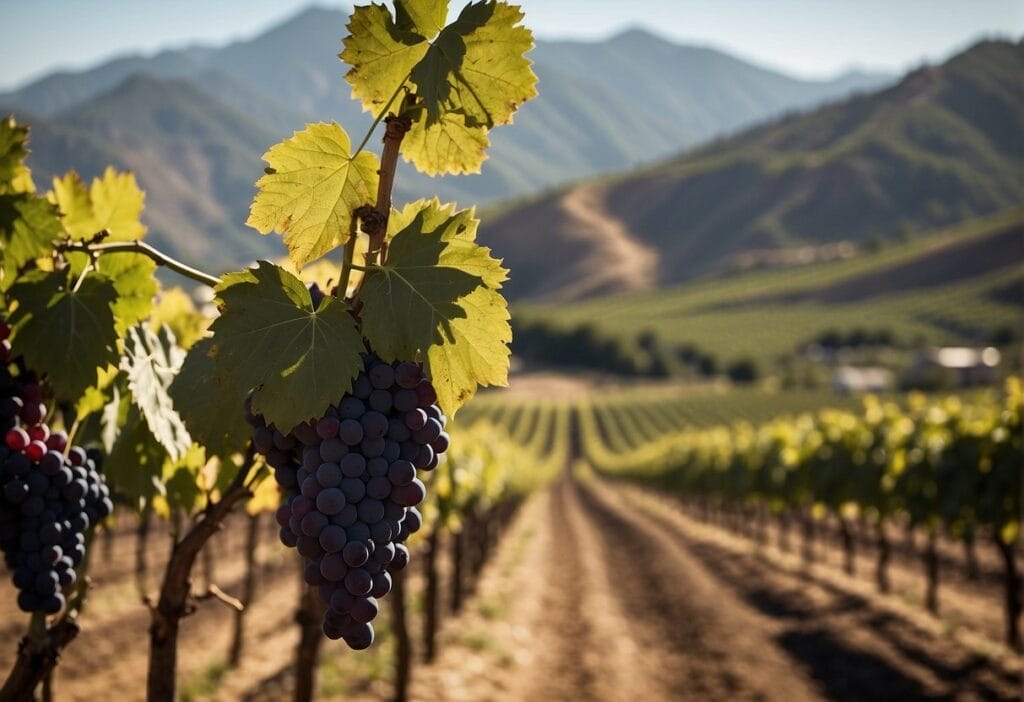
Located 180 miles south of Santiago, the Maule Valley is a prominent wine-producing area in Chile. At this latitude of 35°S, you’ll find a cooler climate suited to a variety of grapes, thanks to the moderating effects of the Maule River which flows from east to west. This region is known for more than just its refreshing temperatures; the river contributes to a rich diversity of soil types, ranging from granite to red clay, loam, and gravel, creating ideal conditions for cultivating vines.
Maule Valley has a rich winemaking tradition and houses some of the country’s most historic vineyards. Here, you’ll typically encounter a focus on red varieties, especially the renowned Carmenère, the grape once thought extinct but rediscovered in Chile.
Viticulture in Maule Valley isn’t just about tradition; it’s also about innovation. While the region was once associated with bulk wine production, there’s a growing commitment to crafting high-quality wines that express the unique terroir of the valley. Your palate may appreciate the bold reds or perhaps the increasingly notable crisp whites from this area.
Notable Grape Varieties:
- Carmenère
- Merlot
- Cabernet Sauvignon
- Sauvignon Blanc
When exploring Maule Valley wines, you’ll taste the dedication to quality and the influence of the cool river breeze in every glass. Don’t hesitate to discover the charm and depth of flavors that Maule’s wines have to offer.
San Antonio Valley

Nestled near the Pacific coast, San Antonio Valley is your gateway to experiencing some of Chile’s most distinctive wines. Here, you’re treated to a cooler climate that’s ideal for growing Pinot Noir, Sauvignon Blanc, and Chardonnay. The valley’s proximity to the ocean means you’ll taste the unique influence of maritime breezes in every glass.
The wines from this region are often characterized by their crisp acidity and minerality, making San Antonio Valley a standout in Chile’s vast wine landscape. When you explore the wines of this area, expect to encounter:
- Pinot Noir: Known for their elegance and complexity with notes of red berries and earthy undertones.
- Sauvignon Blanc: Offers a vibrant freshness with citrus and tropical fruit flavors.
- Chardonnay: Typically, these wines balance richness with a refreshing acidity.
The area’s winemakers are committed to quality, often practicing meticulous vineyard management to ensure that each grape reflects the valley’s terroir. As you taste wines from San Antonio Valley, you’re not just enjoying a beverage; you’re experiencing a piece of Chile’s winemaking heritage.
Remember, your quest for great wine leads you through vineyards that are more than just land and vines; these are places where Chile’s wine identity continues to evolve, promising delightful experiences with every sip. Whether you favor bright whites or nuanced reds, San Antonio Valley has a wine to refresh your palate and invigorate your senses.
Elqui and Limarí Valleys
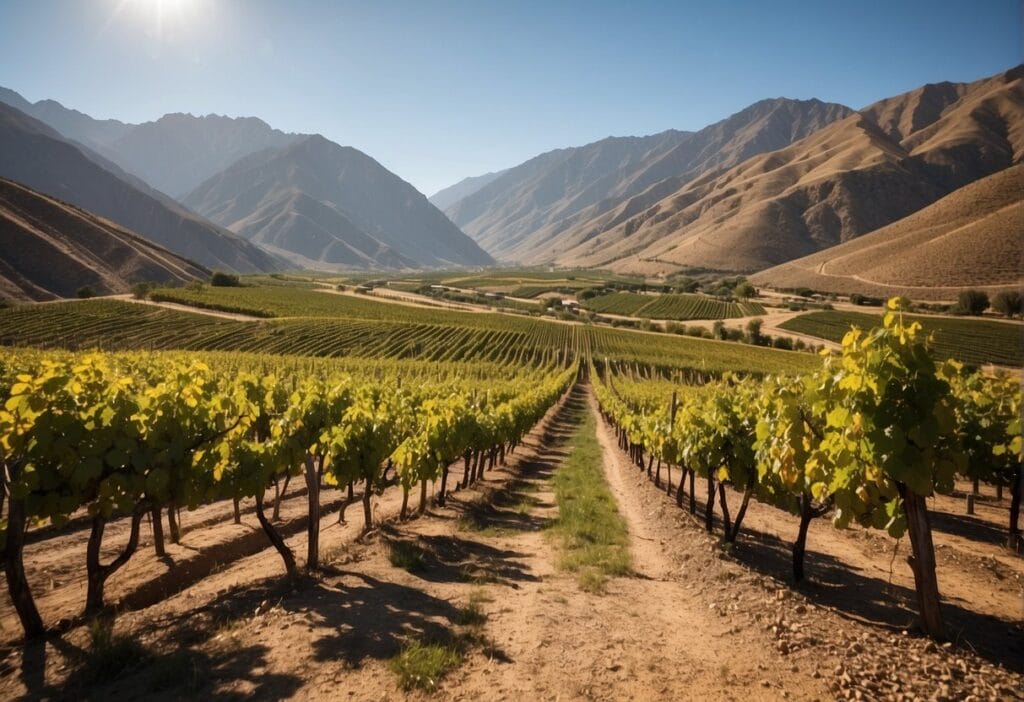
When exploring the rich tapestry of Chile’s wine regions, you’ll find the Elqui and Limarí Valleys nestled in the northern part of the country. These areas are renowned for producing wines with unique profiles, thanks to their distinct climatic and geographical conditions.
Elqui Valley: Here, you’re looking at a region that stretches along the Elqui River. This location benefits from a dry climate and high altitude, which contribute to the intense flavors and aromas found in the wines. Primarily known for table grapes and pisco, a beloved local brandy, the Elqui Valley also produces stellar Sauvignon Blanc and Syrah.
- Grape Varieties:
- Sauvignon Blanc
- Syrah
- Wine Characteristics:
- Intense aromas
- Bright flavors
Limarí Valley: Your taste for white wines will be satisfied here, as Chardonnay takes center stage. Influenced by morning mists known as “Camanchaca,” coming in from the Pacific, this valley’s wines are crisp with minerality. There’s also a strong presence of red varieties like Syrah and Cabernet Sauvignon that thrive in Limarí’s unique terroir.
- Key Points:
- Chardonnay is the dominant white grape.
- Red wines from Syrah and Cabernet Sauvignon grapes are notable.
- Wines exhibit a marked minerality and crispness.
When you visit these valleys, expect to savor wines that truly reflect their terroir. The sun-soaked vineyards, coupled with the cooling fogs and high altitude, make each bottle from these regions a delightful experience.
Bío-Bío and Itata Valleys

In the southern reaches of Chile, you’ll find the Bío-Bío and Itata Valleys, regions renowned for their distinctive wine-producing characteristics. The Bío-Bío Valley is recognized for its challenging weather conditions, including stronger winds and more rainfall compared to other Chilean wine regions.
This cooler climate contributes to the production of wines with high acidity and aromatic intensity. You can further explore the wines and climate of Bío-Bío through this detailed description on Wine-Searcher.
Just to the north, the Itata Valley boasts some of the oldest vineyards in the Americas, rich with history and traditional winemaking practices. It’s known for its rustic landscape, dotted with old vines and colorful farmhouses. The Itata wine region paints a picture of artisanal winemaking, adopting less interventionist tactics to produce distinct and expressive wines. The depth of Itata’s winemaking heritage is beautifully captured in this South America Wine Guide.
Key Varieties
- Bío-Bío: Riesling, Chardonnay, Pinot Noir
- Itata: Moscatel, Cinsault, País
Despite the challenge posed by the climate, these conditions have allowed for the cultivation of cool-climate varietals that flourish and create a unique profile. As you delve into the wines from these regions, you’ll likely notice a focus on terroir and a celebration of the winemaking process that respects the history and nature of the area. To appreciate the geography and viticultural practices in the Itata Valley, take a look at Wine Tourism’s perspective.
Your appreciation for Chilean wines might grow as you explore offerings from these less-heralded yet historically rich valleys. Remember, each sip carries the essence of the land and the legacy of generations of winemakers.
Climate and Terroir

The diverse climates and distinct soils across Chile’s wine regions create a rich tapestry of terroirs, each uniquely shaping the character of its wines.
Understanding Terroir
Your experience with Chilean wines is deeply influenced by the terroir—a French term that refers to the environmental factors, especially soil and climate, that give a wine its distinctive character. Soils in Chile range from coastal alluvial deposits to Andean foothill clay, influencing water retention and vine nutrition.
Climatic Variations
Chile’s extensive length encompasses a variety of climates, from the cool climate influence of the Humboldt Current in the north to warmer inland areas. The cool coastal zones are renowned for their crisp whites and elegant reds, where the marine influence and microclimates provide optimal conditions for slow ripening of the grapes.
Grape Varietals and Wine Styles
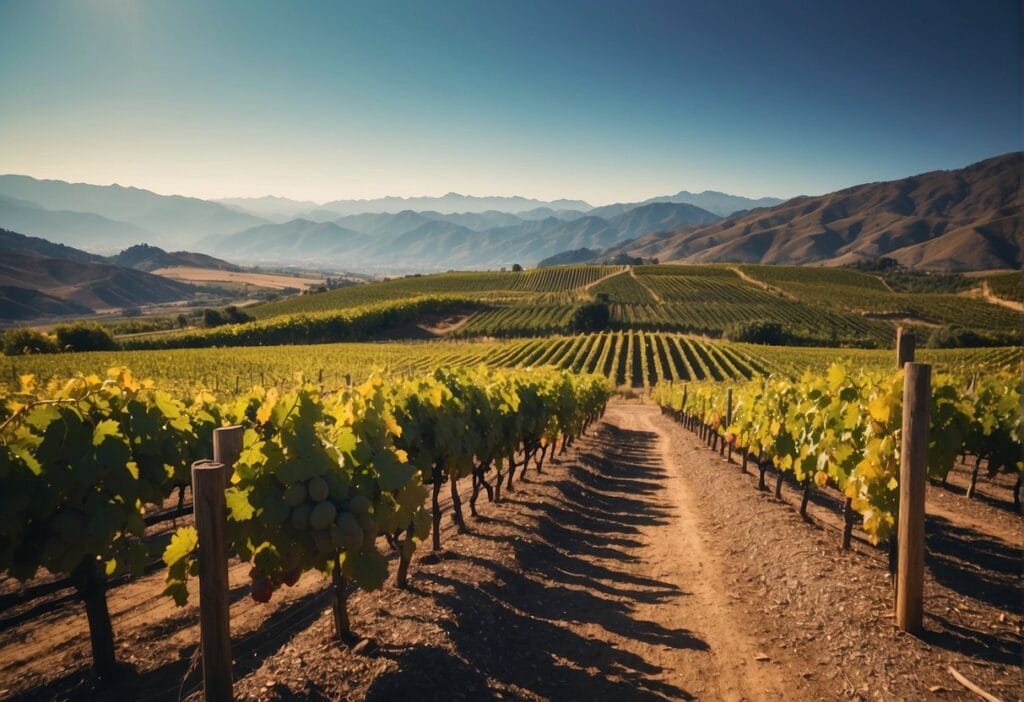
Chile boasts an impressive range of grape varietals, each offering a unique wine style with distinctive flavors and structures. Whether you’re a fan of robust reds or crisp whites, you’ll discover a Chilean wine that suits your palate.
Red Grape Varieties
Cabernet Sauvignon is the most widely planted grape in Chile, renowned for its rich flavor and firm tannins, leading to wines with excellent structure and aging potential. When you savor a Chilean Cabernet, expect a complex experience with layers of cassis, black cherry, and herbal notes, especially from regions like Maipo Valley.
Merlot is another popular varietal, prized for its softer tannins and ripe fruit character, resulting in smooth and approachable wines. Discover the velvety texture of Chilean Merlot, often featuring plum and berry nuances.
As a grape with a legacy, Carménère is Chile’s signature varietal, resurrected after being presumed extinct. It delivers medium-bodied red wines that balance fruitiness with spice, often revealing flavors of red fruits and a touch of green pepper.
Syrah and Pinot Noir represent the more nuanced side of Chilean reds, with Syrah offering bold flavors and an earthy profile, while Pinot Noir tends towards lighter, more delicate aromas and a softer palate.
White Grape Varieties
Sauvignon Blanc thrives in Chile’s cooler coastal areas like the Casablanca and San Antonio Valleys, producing wines with zesty acidity and refreshing citrus notes. It often carries a characteristic herbal essence that makes it unmistakably Chilean.
Chardonnay from Chile can range from clean and crisp to rich and buttery, depending on its region and wine-making techniques. Explore Chardonnay with bright acidity and flavors of tropical fruit from the cooler climates along the coast or a more opulent style from warmer inland areas.
For something a bit different, try a glass of Viognier, with its aromatic profile and elegant floral notes, or a bottle of Riesling, which is less common but valued for its balance of sweetness and refreshing acidity, often with hints of green apple and lime.
Winemaking Techniques and Innovation

As you explore Chile’s prestigious wine country, you’ll notice a pioneering spirit that characterizes local winemaking techniques and innovation. Join us on a journey to discover how cutting-edge practices are shaping the future of Chilean viticulture.
Irrigation and Sustainability
Water management plays a critical role in the sustainability of Chilean viticulture. Techniques like drip irrigation allow producers to deliver precise water amounts directly to the grapevine roots, maximizing efficiency while conserving this precious resource. This practice not only bolsters the vines against varying climate conditions but also enhances the quality of the wine produced.
Winemaking Innovations
In Chile, wineries are revered for their strides in winemaking innovations. Advanced methods like using gravity flow systems in the production process minimize intervention and preserve the grape’s integrity. This innovative approach, along with less invasive filtration methods, reflects a commitment to producing high-quality wines that are true to their terroir.
Organic and Biodynamic Practices
Chilean wine producers are increasingly adopting organic and biodynamic practices. This shift gears toward natural processes that respect the environment and create a holistic balance in the vineyard. Practices such as using organic compost, promoting biodiversity and following lunar cycles for planting and harvesting are becoming more prevalent, showcasing a dedication to crafting wines in harmony with nature.
Wine Tasting and Pairing

As you explore the vibrant wine regions of Chile, knowing how to taste and pair wines can deeply enhance your experience. Here we’ll dive into the essentials of tasting notes and food pairing suggestions.
Tasting Notes
When tasting Chilean wines, pay close attention to the flavor profile and acidity which are indicative of the wine’s quality. Start by observing the color and viscosity. Then, savor the aromas before taking a sip.
Allow the wine to coat your mouth – this is where you’ll detect nuances such as berry notes in a robust Carmenere or the crisp citrus in a Sauvignon Blanc from the cool Casablanca Valley. Reflect on the balance between sweetness, acidity, and tannins which all play a role in the overall taste.
Food Pairing Suggestions
The art of pairing wine with food is about matching the flavors and weight of the wine to your dish, enhancing both. A general guide is to pair lighter wines with lighter foods and fuller-bodied wines with heartier dishes. For instance, a glass of light, refreshing Chardonnay pairs wonderfully with seafood like ceviche, while a bold, earthy Carmenere complements the rich flavors of lamb or beef. Experiment with different combinations to find what tantalizes your palate the most.
Top Vineyards and Wineries

Chile’s diverse landscapes have given rise to a wealth of exceptional vineyards and wineries. From world-renowned producers to boutique estates, you’ll discover wines of remarkable quality and character.
Renowned Chilean Producers
Concha y Toro: Among the most famous names in Chilean wine, Concha y Toro is a must-visit for every wine aficionado. Their Casillero del Diablo range has become emblematic of the region’s vinicultural prowess.
Viña Santa Rita: Known for its superb Carmenere, Viña Santa Rita combines historical charm with outstanding winemaking, offering a glimpse into the soul of Chilean wine tradition.
Viña San Pedro: As one of Chile’s most significant producers, San Pedro has helped put Chilean wine on the map. Your palate will thank you for a taste of their exquisite selections.
Boutique and Artisanal Wineries
Clos Apalta: This smaller scale yet highly lauded winery puts heart and soul into every bottle. Visiting Clos Apalta, nestled in the scenic Colchagua Valley, gives you an intimate experience with wines of exquisite complexity.
Experience the nuanced offerings from Casablanca Valley, where cooler climates give rise to vibrant and refined wines, perfect for enthusiasts looking to uncover the subtle beauties of Chilean viniculture.
Navigating the Chilean Wine Industry

In your exploration of the Chilean wine industry, you’ll discover an intricate blend of vibrant wine regions and a robust export market framed by detailed regulatory practices.
Export and Consumption Trends
Chilean wine is a global ambassador for the country’s rich oenological heritage. With a diverse range of climates across valleys such as Aconcagua, Casablanca, and Maipo, Chile has become one of the top exporters of wine, specifically excelling in varieties like the velvety Carmenere. The wine industry in Chile has seen a steady rise in both production and exportation, with major destinations including the United States, the United Kingdom, and Canada.
- Top Exports: Cabernet Sauvignon, Merlot, Carmenere
- Key Markets: USA, UK, Canada
- Trend: Rising demand for premium wines
Your consumption of these wines contributes to a trend where there’s an increasing appreciation for fine Chilean wines around the world.
Regulatory Framework
As you navigate Chile’s wine industry, it’s crucial to understand the regulations that assure the quality and authenticity of the wine you enjoy. Chile has established a strict regulatory framework to govern the production, labeling, and exportation of wines. This framework ensures that wines meet high standards and accurately represent the regions they come from. These regulations not only protect you as a consumer but also uphold Chile’s reputation as a world-class wine producer.
- DO (Denominación de Origen): Certifies region and grape variety
- Law Decree 464: Governs the wine industry regulations
By understanding these regulatory measures, you gain insight into the meticulous care and tradition woven into every bottle of Chilean wine.
Frequently Asked Questions
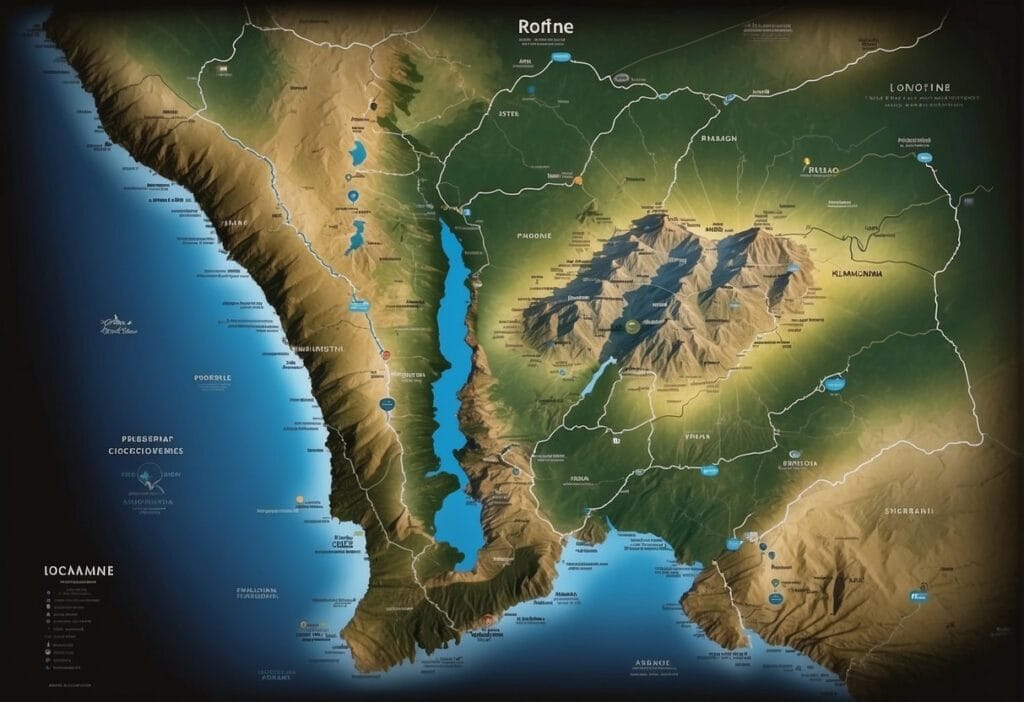
In this section, we address some of the most common inquiries about Chile’s celebrated wine regions. Whether you’re a seasoned oenophile or new to the world of wines, these insights will enhance your knowledge and appreciation for Chilean viticulture.
What varieties of grapes are commonly grown in Chile’s wine regions?
Chile’s diverse climates support a range of grape varieties. Among the most prominent are Carménère, which has become Chile’s signature grape, as well as Cabernet Sauvignon, Merlot, and Sauvignon Blanc.
How does Chile’s wine country compare to that of New Zealand and Argentina?
Chile’s wine regions are known for their exceptional terroirs and microclimates, leading to a broad diversity of wines. Compared to New Zealand, which is famed for its Sauvignon Blanc, Chile excels in both red and white varieties. Against Argentina, notably recognized for Malbec, Chile’s wines stand out through the Carménère varietal. Each country has unique offerings that cater to different tastes.
Could you recommend some exceptional wine tours in Chile?
Certainly, tasting through a selection of great local wines is an experience not to be missed, with tours available that showcase a variety of Chile’s wine-producing regions and winemaking practices.
What are some notable wine brands that originate from Chile?
Chile boasts several globally recognized wine brands such as Concha y Toro and Santa Rita. These brands are renowned for their quality and have helped establish Chile as a major player on the world wine stage.
What are some charming accommodations to consider when exploring Chilean wine country?
Visitors to Chile’s wine country will find a spectrum of lovely accommodations, from boutique hotels to bed-and-breakfasts nestled within vineyards, ensuring a cozy stay as they explore the region’s vinous offerings.
Which historic wine region in Chile is considered the oldest?
The Maule Valley holds the distinction of being the oldest wine region in Chile, where winemaking has deep roots and a tradition that dates back to the Spanish conquest.

